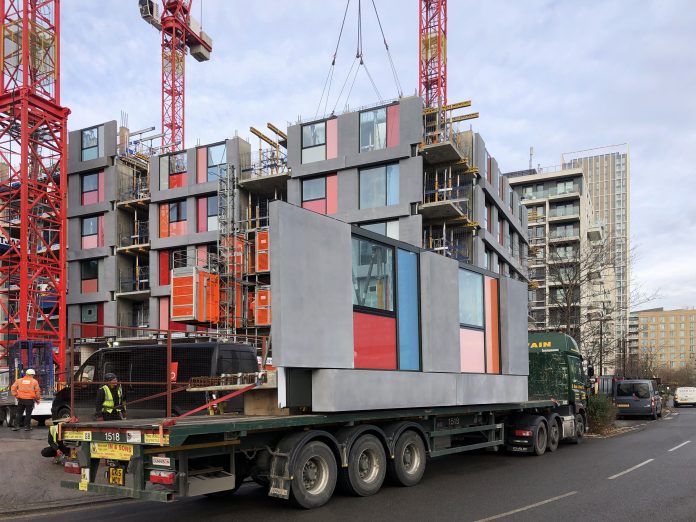The landscape post-Covid may well be a catalyst for the uptake of modern methods of construction and increasing use of digital technology, explains Hawkins\Brown’s partner, delivery director, Nigel Ostime
The building industry has been advocating modern methods of construction (MMC) for some time. Its benefits are known – it is faster, safer and often allows for better quality than traditional on-site construction due to its factory-led production.
Before the Covid-19 outbreak, momentum was already building in the UK for the use of MMC. As we’ve seen with other aspects of our industry, the pandemic has accelerated change and MMC is no exception to this trajectory.
Reports suggest that construction stopped on over 80% of housebuilding sites in April, with some experts warning that post-lockdown annual output may be cut by more than a third. Researchers at Knight Frank estimated that 56,000 fewer new homes would be built in 2020, with only 104,500 completed from the predicted 160,900; already nowhere near the government’s 300,000 homes-per-year target. Assuming that the economy is stretched as a result of Covid-19, we will need to increase productivity not only to meet the original targets but to make up the predicted shortfall.
MMC acceleration
Take-up of modern methods of construction has been slow and only makes up a small percentage of housing delivery. The speedy construction of the Nightingale hospitals has shown the benefits of offsite modular construction and brought it to the fore. But the housing sector has always been reluctant to implement change. The difficulty is usually associated with a lack of capacity and the cost of entry into the market, as well as the stigma against modular building – whether for practical or aesthetic reasons. The industry has seen big players take the plunge and invest heavily in modular housing, including L&G and Goldman Sachs as well as Japanese giant Sekisui, but, on the whole, offsite construction is still seen as an ‘alternative’ to traditional methods, rather than a ‘business as usual’ approach.
Covid-19 may well have provided a tipping point. The need for social distancing measures, for one, complicates traditional methods of construction, with many sites risking being unable to function as government guidelines continue to fluctuate in severity up and down the country. MMC’s focus on components being pre-fabricated offsite creates a reduction in the number of site operatives required to facilitate building and could accelerate a faster – and more consistent – transition for housebuilders as social-distancing measures continue.
Social distancing is far more achievable in factory-based assembly settings and subsequently reduces the number of on-site operatives to enable social-distancing on site. Additionally, the worldwide reduction of carbon emissions and other pollutants observed during lockdown was widely received as a beneficial side-effect of the pandemic; and, while only a short-term relief, can continue to be better controlled through the better environments provided by offsite construction.
Understanding offsite systems
Architects and other designers need to have a comprehensive knowledge of the offsite systems available and then select the right one for the specific site and building type. Last year the government helpfully defined seven categories of MMC. Category 1 is 3D volumetric, which in many people’s eyes is what is meant by ‘modular’. But it is just one of the options and in fact is the most difficult to implement. The other categories, particularly Category 2 (2D panelised systems), Category 3 (non- systemised structural components) and Category 5 (non- structural 3D assemblies), are all more straightforward and require a lower level of up-front investment, which can be a barrier.
The term pre-manufactured value (PMV) has started to be used to describe the percentage of a building that is pre-manufactured in a factory and brought to site for assembly, as opposed to traditional forms of construction. A high level of PMV would be about 75-80% for a fully volumetric building. But good levels of PMV can be achieved with the other categories. Hawkins\Brown’s 524-unit build to rent scheme at Plot N06, East Village in Stratford, uses a variety of systems (not including Cat 1) and is achieving around 60% PMV. In doing this, months have been shaved off the site programme, bringing increased revenue to the operator. Critically, the additional pre-assembly has meant that operations on site have not been affected by Covid-19 in the same way that other, traditionally constructed developments have. Plot 06 uses an innovative system brought over from Australia that combines floor slabs with curtain walling. This, along with bathroom pods, pre-fabricated service risers, pre-fabricated internal wall systems and other offsite methods, has taken months off the programme.
Offsite also improves predictability and, as the colder months draw near, this is another key consideration, particularly if Covid-19 infection rates increase during the winter. With the impending demographic skills shortage, not to mention the impact of Brexit, the construction industry needs to find ways of reducing its reliance on labour anyway. MMC, aligned with digital tools and a more collaborative process, will provide this.
There have already been calls in the market for the government to designate land exclusively for factory-built homes. Earlier this month, Housing Secretary Robert Jenrick announced that at least 20% of all new homes to be built through the government’s £12bn affordable homes programme should be built using MMC. This is a promising start and an avocation of the importance of changing methodologies for delivering much-needed housing.
The post-Covid-19 landscape may well be a catalyst for wider uptake of MMC and an increased use of digital technology. This would be a welcome transition into more efficient, sustainable and stable working methods which will see a greater number of housing targets met. All that is needed is a shift in mindset and an increase in design quality, which can only be achieved through mass adoption.
Nigel Ostime
Partner, delivery director
Hawkins\Brown
Twitter: @Hawkins_Brown
LinkedIn: Hawkins\Brown














